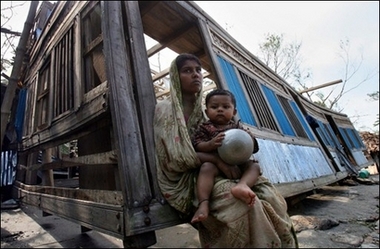Bangladesh says cyclone death toll hits 2,000
Updated: 2007-11-18 15:13
DHAKA - Bangladesh said Sunday the death toll from a massive cyclone hit 2,000, with that grim tally certain to rise as the impoverished country struggled to get aid to millions of people left homeless.
 A cyclone-affected Bangladeshi mother sits with her child at their devastated house in Moralganj, on the south coast of Bangladesh, 17 November 2007. [Agencies] |
The death toll has been jumping by hundreds at a time as rescue workers fight their way to remote areas where entire villages were flattened by the fury of Cyclone Sidr, which tore through south Bangladesh on Thursday night.
"I have never seen such a catastrophe in my 20 years as a government administrator," said Harisprasad Pal, a local official in the hard-hit southern district of Jhalokati.
"Village after village has been shattered," he said. "Millions of people are living out in the open and relief is reaching less than one percent of the people."
The army and aid workers were still struggling to reopen roads to areas where most of the homes, fragile structures made of bamboo or tin that were blown away by the storm, have been wiped out.
In many places, villagers said, the dead were quickly being buried in mass graves.
"We have confirmed 2,000 deaths and it is constantly increasing as we get more reports from affected districts," said Masood Siddiki, director general of the government's disaster management bureau.
Along the country's ravaged southern coast, home to some of the world's poorest people, officials were expecting to find thousands of bodies once everyone had been accounted for.
Struggling relief workers used elephants to pull fallen trees blocking roads and preventing help from reaching many areas.
Meanwhile survivors, returning from cyclone shelters, have come home to scenes of total devastation. In many places there is no electricity, and officials have warned it could take weeks to restore.
The deputy commissioner of Jahlokati, K.M. Rahatul Islam, said every one of the 554 villages in his district had been hit by the cyclone.
"All the tin-built houses were blown away," he said. He called the scene "a great human tragedy".
Most of the deaths were caused by flying debris and trees falling onto flimsy bamboo and tin homes -- the best most people in Bangladesh can afford.
"I have never seen such a terrible scene. It was like hell. I saw dozens of tin roofs flying into the air. Whole houses too," said local businessman Manik Roy, 50, who sat out the cyclone huddled in a shelter.
In the village of Charkhali, close to the coast, more than 100 people died and 30 were missing after a six-metre (20-foot) wall of water engulfed the area.
"The wind and the tidal surge were so strong that it churned up four kilometres of a tarmac road," said resident Anowar Hossen Khan.
Army helicopters were dropping supplies from the air while five navy ships were distributing food, medicine and relief materials along the coastline, the site of the world's largest mangrove forest and the natural habitat of the Royal Bengal tiger.
Germany, Britain, the United States and the European Commission expressed their sympathy and made offers of immediate relief aid.
"We have offered our immediate support to relief efforts through the UN and stand ready to provide more assistance when required," said British foreign office minister for Asia, Mark Malloch Brown.
The European Commission said it was sending 1.5 million euros (2.2 million dollars) in emergency relief aid to the country.
|
|
|
||
|
||
|
|
|
|